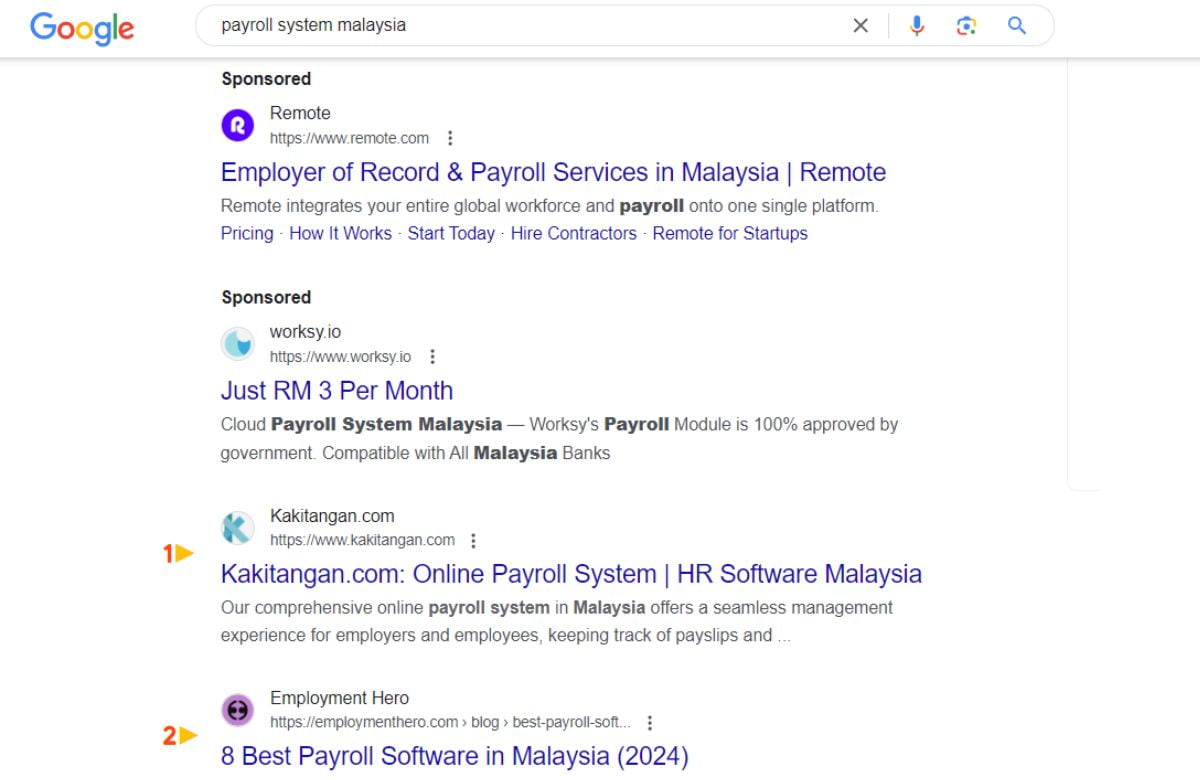Are you struggling to increase traffic to your website in Malaysia? If so, you’re not alone. With the vast amount of online competition, standing out in search engine results pages (SERPs) can be challenging. In the digital age, having a robust online presence is essential for businesses to succeed.
One of the most effective ways to drive traffic to your website is through search engine optimization (SEO); when it comes to SEO, the results still reign supreme. However, achieving a high ranking on Google’s search engine results page is challenging, especially in a country as competitive as Malaysia.
If you’re looking to boost your website traffic in Malaysia, you’ve come to the right place. In this article, we’ll share tips and tricks to help you unlock the power of Google SEO and improve your search engine ranking. Whether you are a small business owner or a digital marketer, these tips will help you stay ahead of the game and drive more traffic to your website. So, without further ado, let’s dive in!
What Is Google SEO Malaysia?
SEO stands for search engine optimization. It is the practice of optimising your website’s content and structure to improve its visibility and rankings in search engine results pages (SERPs). SEO aims to increase the quality and quantity of organic traffic to your website by making it easier for search engines like Google to understand what your website is about and recommend it to users looking for content related to your website.
Several elements go into optimising a website for SEO marketing, including keyword research, on-page SEO, technical optimization, and off-page SEO. SEO is an ongoing process that requires continuous monitoring and refinement. As search engines evolve and update their algorithms, staying up-to-date with the latest SEO trends and best practices is essential. Investing in SEO Malaysia can improve your website’s visibility and attract more targeted traffic, ultimately leading to increased conversions and revenue.
Crack The Code: Understanding Google SEO In Malaysia

Understanding Google SEO process in Malaysia is essential for any website owner who wants to increase their visibility and attract more traffic. Google SEO is the process of optimising your website’s content, structure, and other elements to improve its visibility and rankings in Google’s search engine results pages (SERPs). Google is the most popular search engine in Malaysia and worldwide, making it a critical focus for SEO efforts.
Where Search Is Heading
As technology advances, so does the way we search for information online. Search is constantly evolving, with new technologies and trends always emerging. In recent years, we’ve seen a rise in voice search, mobile search, and visual search, all of which have significant implications for SEO that shape the future of search. With voice assistants like Siri and Alexa becoming increasingly popular, optimising your website for voice search is becoming more critical than ever. Similarly, with more and more people using their smartphones to browse the internet, mobile search is quickly becoming the norm. And with the rise of visual search tools like Google Lens, it’s clear that images and videos are becoming more critical for SEO. By keeping up with these latest trends and optimising your website, you can stay ahead of the curve and attract more targeted traffic.
Why Search Engine Optimization Focuses On Google
If you’re a website owner, you’ve probably heard about SEO and how it can help boost your website’s traffic. But have you ever wondered why SEO focuses on Google? The answer is simple: Google is the king of search engines. With over 90% of the global market share, Google is the go-to choice for most people searching for information online. Google search is even more dominant in Malaysia, with over 97% of the market share. This means optimising your website for Google SEO is crucial if you want to reach a large audience and attract more traffic.
But it’s not just about popularity. Google’s algorithm constantly evolves, making each update more intelligent and sophisticated. To succeed in SEO, you must stay on top of the latest trends and updates and tailor your strategy to Google’s priorities. Doing so will ensure your website is visible to your target audience and ranks well in Google’s search results.
What Google Wants From Your Website
When optimising your website for Google SEO, it’s essential to understand what Google wants. After all, Google is the gatekeeper to the vast world of online information, and it’s necessary to meet its standards if you want to be seen and heard. So, what exactly does Google want from your website?
First and foremost, Google wants to provide its users with the best possible user experience. This means delivering the most relevant and high-quality content for their search queries. So, if you want to rank well in Google’s search results, you need to focus on creating valuable and relevant content that meets the needs of your audience. This includes using targeted keywords and providing comprehensive, informative content that answers their questions and satisfies their search intent.
But it’s not just about the content – Google also looks for technically sound websites and is easy to navigate. This means having a website that loads quickly, is mobile-friendly, and has a clean and organised structure. A website that is cluttered or difficult to navigate will not only frustrate users but will also hurt your SEO rankings.
Organic VS Paid Search Result

Are you wondering what the difference is between organic and paid search results? Both search results can help your website attract more traffic but have different advantages and disadvantages.
Organic Search Results
Organic search results are the non-paid listings that appear in Google’s search results pages (SERPs) when someone types in a search query. These results are based on Google’s algorithm, which ranks websites based on various factors, including content relevance, backlinks, user experience, and technical aspects.
Paid Search Results
Paid search results are the ads that appear at the top of Google’s search results pages (SERPs) when someone types in a search query. These results are based on a bidding system, where advertisers bid on specific keywords and pay each time someone clicks on their ad.
So which one should you choose for your business? The answer depends on your specific goals, budget, and timeline. Organic search results can provide long-term benefits and save you money on advertising costs, but they require ongoing efforts to maintain your rankings. Paid search results can give fast results and highly targeted traffic, but they need a budget for advertising costs and may provide short-term benefits. Consider your goals and resources carefully before deciding which one to pursue.
Here’s a table summarising the key differences between organic and paid search results:
| Organic Search Results | Paid Search Results |
| – Free | – Require a budget for advertising costs |
| – More trusted | – May not be trusted by some users |
| – Long-term benefits | – Do not provide long-term benefits |
| – Takes time to rank well | – Provide fast results |
| – Unpredictable | – Highly targeted |
| – Offer more control over messaging |
Exploring The Types Of SEO Services In Malaysia

When it comes to search engine optimisation (SEO), it’s essential to understand that different types of SEO can be applied depending on the goals of your website. In Malaysia, several types of SEO and Google SEO services are commonly used by website owners to optimise their sites for search engines.
Local SEO
Local SEO is a crucial strategy for businesses that operate in a specific geographic area. Optimising your website for local searches can increase your visibility and attract more local customers. To improve your local SEO, you must optimise your Google My Business listing, including your name, address, and phone number. You’ll also need to include location-specific keywords on your website, such as your city’s or neighbourhood’s name. Additionally, it’s essential to have consistent and accurate information about your business across all online directories and platforms.
Technical SEO
Technical SEO is all about optimising the technical aspects of your website to make it easier for search engines to crawl and index your site. This includes optimising your website’s code and architecture to improve site speed and user experience. To improve your technical SEO, you’ll need to make sure your website is mobile-friendly and has a responsive design. You’ll also need to optimise your site’s metadata, including title tags, meta descriptions, and header tags. Additionally, you’ll need to ensure your site’s URL structure is optimised for search engines.
E-Commerce SEO
E-commerce SEO is a strategy online stores use to improve their search engine rankings and attract more customers. To improve your search engine results through e-commerce SEO, you must optimise your product and category pages with relevant keywords and descriptions. You’ll also need to optimise your site structure and internal linking to make it easier for users to find and purchase your products. Additionally, you’ll need to optimise your site for transactional keywords, such as “buy” or “order.”
International SEO
International SEO is a strategy used by businesses that operate in multiple countries and languages. Optimise your site’s content, structure, and hreflang tags for different languages and cultures to improve your international SEO. This includes translating your site’s content into other languages and optimising it for specific keywords and user intent. Additionally, you’ll need to make sure your site is structured in a way that makes it easy for search engines to identify and serve the correct language and country version of your site.
Content SEO
Content SEO is a strategy to optimise your website’s content for search engines. This includes creating high-quality, relevant, engaging content optimised for specific keywords and user intent. To improve your content SEO, you’ll need to conduct keyword research to identify relevant keywords and phrases to target. You’ll also need to make sure your content is structured in a way that is easy for search engines to crawl and index. Additionally, you’ll need to optimise your site’s internal linking to ensure that your content is easily discoverable by search engines.
Multilingual SEO
Multilingual SEO is a strategy used to optimise your website for multiple languages. This includes translating your site’s content into different languages and optimising it for specific keywords and user intent. You must conduct keyword research for each language and culture you’re targeting to improve your multilingual SEO. You’ll also need to make sure your site’s structure and hreflang tags are optimised to serve the correct language and country version of your site to users.
By understanding the unique benefits of each type of SEO and implementing the appropriate marketing strategies, you can improve your website’s visibility and attract more traffic and customers.
The Inner Workings Of SEO

Have you ever wondered how Google determines which websites to show on the first page of search results? The answer lies in search engine optimization or SEO. In a nutshell, SEO is the process of optimising your website to rank higher in search engine results pages (SERPs). But how exactly does it work?
Search engines like Google use complex algorithms to analyse and rank websites based on various factors, including relevance, authority, and user experience. SEO involves optimising your website to align with these factors to improve your website’s visibility and rank higher in search results.
One of the primary factors that search engines consider when ranking websites is relevance. This means that your website should provide high-quality, relevant content that matches the user’s search intent. To achieve this, you’ll need to conduct thorough keyword research to identify the search terms and phrases pertinent to your business and target audience.
Another critical factor is authority. Search engines look at the number and quality of links that point to your website to determine its authority and trustworthiness. This means you’ll need to build high-quality backlinks from reputable sources to improve your website’s authority and credibility.
User experience is also a crucial factor in SEO. Search engines prioritise websites that provide a positive user experience, including site speed, mobile-friendliness, and ease of navigation. To improve your website’s user experience, you’ll need to focus on optimising your site’s design, structure, and functionality.
Search Engine Optimisation Ranking Factors

Search engine optimization (SEO) ranking factors are the key elements that determine how your website ranks in search engine results pages (SERPs). These factors are used by search engines such as Google to determine the relevance and authority of your website for specific search queries.
Content Quality And Relevance
The quality and relevance of your website’s content are essential for improving your website’s rankings. High-quality content is engaging, informative, and satisfies user intent. Using relevant keywords and multimedia and providing valuable information that answers users’ questions is essential for improving your website’s rankings. By creating quality content, you can increase the chances of your website appearing at the top of search engine results pages.
Backlinks
Backlinks are links from other websites that point to your website. They are an essential ranking factor that can improve your website’s authority and trustworthiness. Backlinks from high-quality, relevant websites carry more weight than those from low-quality or irrelevant sites. The more links you have pointing to your site, the more likely search engines will view your site as a reputable source of information.
User Experience
User experience is crucial for improving your website’s rankings. A positive user experience includes site speed, mobile responsiveness, and ease of navigation. By providing users with a user-friendly experience, you can increase their time on your site, reduce bounce rates, and improve your website’s rankings.
On-Page Optimization
On-page optimization factors such as title tags, meta descriptions, header tags, and internal linking are essential for improving your website’s rankings. By optimizing your site’s on-page elements, you can make it easier for search engines to crawl and index your site’s content. This can improve your website’s relevance and authority for specific search queries.
Technical Optimization
Technical optimization factors such as site speed, architecture, and schema markup are crucial for improving your website’s rankings. By optimizing your site’s technical elements, you can make it easier for search engines to crawl and index your site’s content. This can improve your website’s relevance and authority for specific search queries.
In addition to these factors, several other SEO ranking factors can impact your website’s rankings, including social signals, domain age, and local search optimization. By focusing on these fundamental SEO ranking factors and implementing the appropriate strategies, you can improve your website’s visibility, attract more traffic, and drive more conversions and revenue for your business.
Picking The Perfect SEO Strategy For Your Business

Choosing the right SEO strategy is crucial for improving your website’s rankings and attracting more traffic. With so many different approaches to SEO, it can be challenging to know which one is right for your business. SEO is a crucial aspect of digital marketing, and choosing the right SEO strategy can make all the difference in the success of your online presence. Here are some key factors to consider when choosing the right SEO strategy for your business.
Your Business Goals
Before you start any SEO strategy, you must define your business goals. Do you want to increase brand awareness, drive traffic to your website, or generate more leads and conversions? Your goals will influence your SEO strategy, as different tactics will help achieve other goals.
Your Target Audience
Your target audience is another essential factor when choosing the right SEO strategy. Who are you trying to reach, and what are their needs and interests? By understanding your target audience, you can create content and optimize your site to meet their needs better and attract more traffic.
Your Competition
Analyzing your competition is an integral part of choosing the right SEO strategy. Who else is ranking for the keywords and topics you’re targeting, and what are they doing to achieve those rankings? By analyzing your competition, you can identify gaps and opportunities in your SEO strategy and adjust accordingly.
Your Budget
Your budget is another crucial factor when choosing the right SEO strategy. Different SEO strategies require different investment levels, and selecting a plan that fits your budget is essential. While some techniques, such as content creation and link building, can be done in-house, others, such as technical optimization, may require the help of a professional SEO company Malaysia.
Your Timeline
It’s essential to consider your timeline when choosing the right SEO strategy. SEO is a long-term strategy that can take several months to see significant results. If you need to see quick results, consider supplementing your SEO strategy with paid search or social media advertising.
By considering these key factors and working with an experienced SEO professional, you can choose the right SEO strategy for your business and achieve your goals of improving your website’s rankings and attracting more traffic.
Powerful SEO Strategies For Your Website’s Rankings

If you want to improve your website’s rankings in search engine results pages (SERPs), you need a strong SEO strategy. Here are three powerful SEO strategies that can help boost your website’s rankings and attract more organic traffic.
Content Creation And Optimization
Creating high-quality content optimized for users and search engines is one of the most essential SEO strategies you can implement. When you create valuable and engaging content for your target audience, you’re more likely to attract backlinks, social shares, and other signals of authority that can help boost your website’s rankings.
To create content optimized for search engines, you need to conduct keyword research to identify the phrases and topics your target audience is searching for. Use these keywords strategically in your content, including in your headlines, subheadings, and throughout the body of your content. However, avoid keyword stuffing, as this can hurt your rankings.
Technical Optimization
Technical optimization refers to optimizing your website’s backend to improve its performance and user experience. This includes page load speed, mobile responsiveness, and site structure.
Ensuring that your website is technically optimized makes you more likely to rank higher in search results and provides a better user experience. Use a fast and reliable web hosting provider, compress your images to reduce file size, and use a responsive design that adapts to different screen sizes.
Link Building
Link building is acquiring backlinks from other websites to your own. When other websites link to your content, it signals to search engines that it is valuable and authoritative, which can help boost your rankings.
To build links to your website, you can contact other websites in your industry and ask them to link to your content. You can also create high-quality content that’s likely to attract backlinks naturally. Additionally, you can participate in online forums and communities to build relationships with other website owners and potentially secure backlinks.
Implementing these three powerful SEO strategies can help improve your website’s rankings and attract more organic traffic over time. However, remember that SEO is a long-term strategy, and it may take several months to see significant results. By staying consistent and committed to your SEO efforts, you can achieve long-term success for your website’s rankings and overall online presence.
Decoding SEO Pricing

SEO pricing can be complex and confusing, with many options and services available. If you’re looking to invest in SEO services for your business, it’s essential to understand the factors that influence pricing and what you can expect to pay for different service levels.
Here’s a breakdown of critical factors that can influence SEO pricing and how to decode the various pricing models.
Service Type And Scope
The type and scope of services you require will significantly impact your SEO pricing. For example, if you’re looking for a comprehensive SEO strategy that includes everything from keyword research to content creation to technical optimization, you can expect to pay more than if you’re only looking for basic on-page optimization.
Provider Experience And Reputation
The experience and reputation of your SEO provider can also impact pricing. Established and well-regarded providers may charge more for their services, but they may also offer higher expertise and results.
Location And Market Competition
The location and competitiveness of your target market can also influence SEO pricing. If you’re targeting a highly competitive market, such as a central metropolitan area, you may need to invest more in SEO services to stand out.
Pricing Models
There are a few different pricing models that SEO providers may use, including hourly rates, monthly retainers, and project-based pricing. Each model has advantages and disadvantages, so it’s essential to understand how they work and which one best fits your needs.
Overall, the key to decoding SEO pricing is to understand the specific services you need, the level of expertise you require, and the competitiveness of your market. By doing your research and choosing an SEO provider that’s transparent about its pricing and services, you can invest in SEO with confidence and achieve the results you’re looking for.
How User Intent Drives SEO Results
Understanding user intent is critical to driving results when it comes to SEO. User intent refers to the reason behind a user’s search query or what they hope to accomplish by performing a search. By understanding user intent, you can create content that better aligns with what users are looking for, which can improve your website’s rankings and attract more traffic.
For example, if a user is searching for “best restaurants in Kuala Lumpur”, their intent is likely to find recommendations for restaurants in the city. By creating content that provides detailed reviews and recommendations for restaurants in Kuala Lumpur, you’re more likely to rank higher in search results and attract interested users.
To understand user intent, you must conduct keyword research and analyze search queries to identify common themes and patterns. You can also use tools like Google Analytics to analyze user behaviour on your website, such as what web pages do they visit and how long they spend on each page.
Once you understand user intent, you can create content tailored to their needs and interests. This includes using relevant keywords throughout your content, making engaging and informative headlines, and providing valuable information that aligns with users’ needs.
Additionally, you can optimize your website’s structure and navigation to make it easier for users to find what they want. This includes creating clear and descriptive page titles and meta descriptions, using header tags to structure your content, and providing internal links to related content on your website.
By prioritizing user intent in your SEO strategy, you can create a more user-friendly website optimised for users and search engines. This can improve your website’s rankings and attract more traffic over time, leading to long-term success for your online presence.
Exciting New Trends In SEO

SEO is a constantly evolving field, with new trends and best practices emerging all the time. Here are some of the most exciting new trends in SEO that you need to know about:
- Voice search optimisation
- Featured Snippets
- Video SEO
- Mobile-first Indexing
- User experience (UX) Optimisation
- Local SEO
- Artificial Intelligence and Machine Learning
Stay Ahead Of The Curve With IMarketing
SEO is vital to any successful digital marketing strategy, and staying up-to-date on the latest trends and strategies is crucial for success. By understanding the different types of SEO and optimizing for key ranking factors, you can improve your website’s visibility and attract more traffic to your site.
To stay ahead of the curve, rank higher in Google search ranking and achieve lasting success in SEO and digital marketing services, it’s important to partner with iMarketing, an experienced and reputable SEO company in Malaysia. Our team of SEO specialists can help you develop and implement a customized SEO strategy tailored to your specific business needs and goals.
So if you’re ready to take your website’s rankings to the next level, contact iMarketing today to learn more about our comprehensive SEO services and start achieving real results. Contact us now for free SEO consultation with our prominent SEO consultants and SEO experts.






